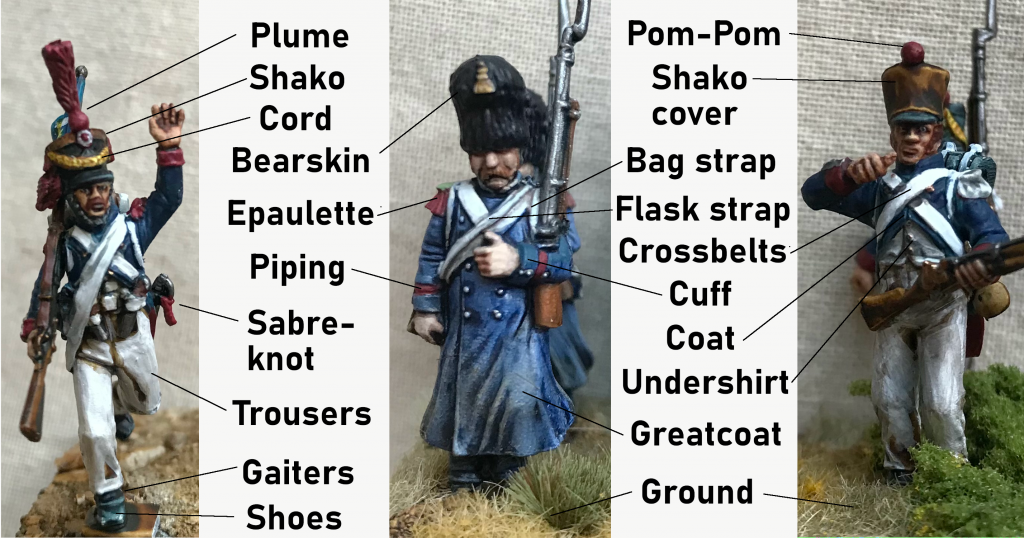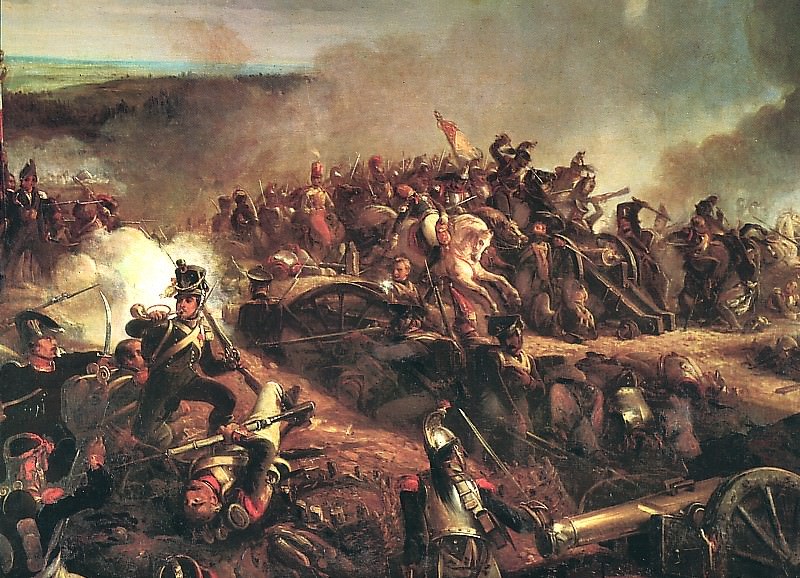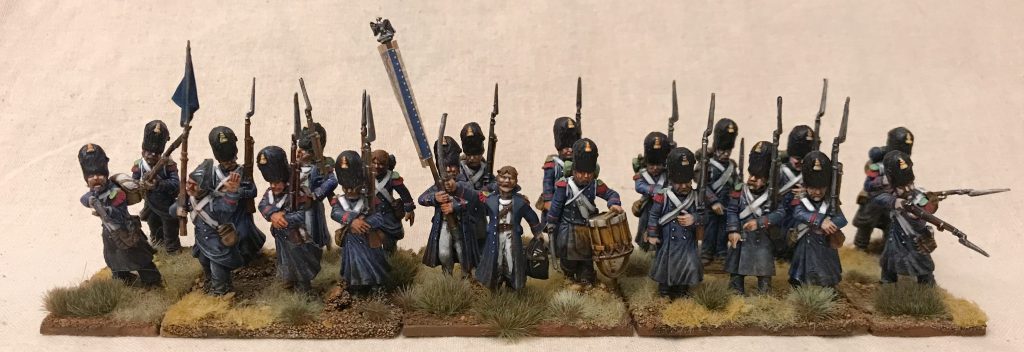We left off last time with me careering around the early stages of building and researching a Napoleonic army, with 62 poorly painted Guardsmen and one fairly well painted Guardswoman and a vague impression of post-revolutionary French history to show for a couple of weeks of unfocused charging to and fro like a drunk Hussar.
No longer! If this is to be anything other than a passing fancy, or a gaming project picked up and discarded shortly after, I need to be thinking of the words on all these tiny flags that come in the boxes: Valeur et Discipline – especially the Discipline bit. I need an actual plan, some level of understanding of how to pull it off, and a paint scheme for blue, white and red that won’t drive me up the wall. To get that started, I need to think about uniforms.
A man becomes the creature of his Uniform
Napoleonic Uniforms – of all nations and combatant powers – are very probably the apogee of the European trend towards equipping soldiers in the fanciest shit money could buy. They are complicated, fiddly, brightly coloured things designed by soldiers, artists, costumiers and madmen. The uniforms didn’t just make soldiers look, well, uniform, their sheer fanciness was important to making them visible and distinguishable across crowded battlefields. Keeping to uniform regulations was a helpful way of breaking in new soldiers, and giving young men who’d maybe only ever worn wooden sabots, trousers and a ragged smock smart, flashy uniforms made them feel like warrior gods (and might even have convinced a few not to desert).

Now these men are shrunk to between 25 and 30mm though, all that uniform fanciness can make them impossibly intimidating to paint. Peering at grey plastic over the last few weeks I’ve struggled sometimes to even make out which bits are supposed to be which, and trying then to work out exactly how I’m going to convert the pile of shame into a Guard army has been bloody difficult. Most instructions, guides or sources on uniform colours use a lot of technical vocabulary – see my intro freakout in part 2 for example – that you are, to some extent, simply expected to know. With my Greatcoated Guard painted, I now have a lot of similar looking plastics to sort into the right companies and regiments and they need to be painted in their various distinct ways. To make this easier, I’ve made a little note card based on a simple guide to the French uniforms I’m working with. This is pinned up above my painting area and will remain there until morale improves I can remember what everything is off the top of my head.
Using this, I’ve drawn up a couple of “target regiments” that will give me some good visual interest, are accurate to the Guard formations of 1813. Using the diagram to make tables means that I can do a little research, decipher the occasionally oblique references to uniform colours, and then jot it down in a format that’s easy and clear enough to pick up a base of 6 men and just get cracking for half an hour after work. Painting Napoleonics without stopping to check on the internet if I’m going the right way has been a challenge – this is my solution.
| Regiment | Core | Lapels | Turnback | Piping | Pom-Pom | Epaulette | Cuffs |
| Velites de Turin | Blue | White/Blue | Red | white? | Red | White/Red | Red |
| Flanquers-Chasseurs | Green | Green | Red | Yellow | Green/Yellow | None | Green |
| Saxon Grenadiers | Red | Yellow | Yellow | none | White | White | Yellow |
You might have noticed that “trousers” and all the super complicated bits of below the waist uniform aren’t on the table (if you did, and be honest, you are awarded one shiny Murat point for uniform pedantry). There’s a couple of reasons for that. First off, most of the men I’m painting are modelled with overall-style trousers that historically seem to have been blue, white, off-white, grey and brown, in addition to occasionally ragged, stripy and, I’m sure, heavily stained. So I’m not worried too much. Secondly though is that I’d like my army to be in campaign or battle uniform. Infantry Regiments could have four uniforms: Full Parade, Campaign, March and Exercises. But my guys aren’t on parade, or marching along, they’re 12 inches away from the enemy line, and I want them grimy, stained and occasionally injured. So the gaiters, socks, tights, leggings and all that isn’t so relevant for me*. So everyone’s going to get trousers, and most of them will be a satisfying off-white colour unless the regiment specifically wore otherwise, or I get bored painting off-white and mix it up.
*Yes, some regiments – and occasionally whole armies – did fight in full parade uniform, but mine don’t because I don’t have 80 models in full parade uniform to paint.
There’s also a bit of a practical consideration here. I do want everyone to be in a vaguely right uniform, but I bought mix of models from before and after France’s great uniform change in 1812 (the “Bardin Regulation”). Luckily, building for the punch-drunk days of 1813 means mixing and matching even within the same company is 100% historically accurate. If I stick to the right schemes, the sometimes very different pre and post 1812 uniforms will be visually congruous within the units and create the feeling of hurriedly scraped up reinforcements, rather than the feeling of “this guy isn’t taking uniform seriously enough” which might be the biggest, most mortal-est, sin a Napoleonics player can commit.
Soldats! Je suis content de vous
Using the uniform guide, over the last two weeks I’ve been cracking on with some repaints and adding another solid unit of line infantry to the Guard. As I go on with these, I’ll give a very short potted history of the units that muster on my cutting mat, including any conversions, modelling choices and sources for models and materials.
1st Regiment of Chasseurs a Pied, Old Guard
Given a bit of a zhuzh and a new flag since they last graced goonhammer, the first batallion of the Old Guard is finally fully ready to go. The 1st Chasseurs (hunters) a Pied were one of the OG Old Guard units, formed out of the consular guard in 1804. They took serious hard men – five (and later 10 year) veterans who had fought in three campaigns and were at least functionally literate. At this point this would have included men who’d fought with Napoleon in his days as an artillery Lieutenant, the occasional man back from Egypt and veterans of Marengo, the first battle where Napoleon really exploded onto the world stage. They were the “light” equivalent of the giants of the Grenadiers – lighter in the literal sense, taking those eligible for the Old Guard who were between five foot eight and five foot ten. Losing thousands in 1812, in my army they’re the veterans of brutal guerrilla fighting in Spain, Germany and Italy, the Oldest of the Old Guard, guys who could chew up muskets and spit bullets, with men from all over the Empire in their ranks. Along with the Grenadiers, they were one of the legendary last stands at Waterloo, holding Placenoit in the face of an endless horde of Prussians.
This unit is entirely the Victrix Old Guard.
Velites de Turin
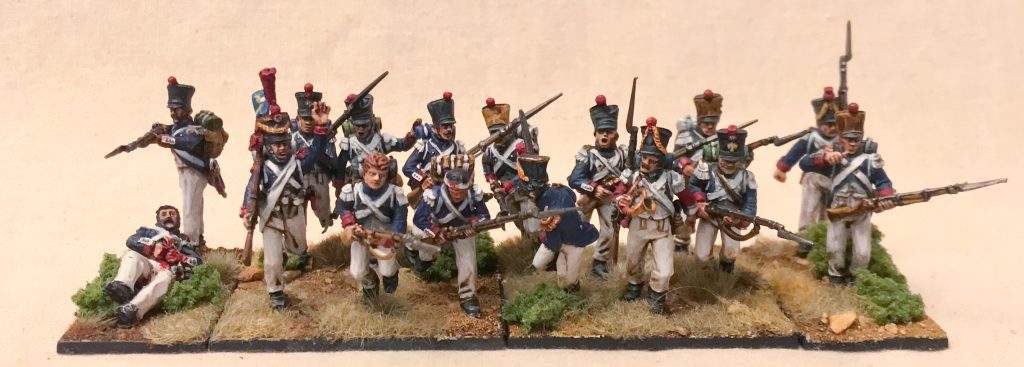
The Turin Velites were, unsurprisingly, an Italian regiment raised after the annexation of Piedmont to the French Empire in 1802, initially (I think) as a bodyguard to Napoleon’s brother in law, Camillo Borghese. They became part of the Guard, as one of the units of Middle Guard in 1810. Velites were an interesting part of the Guard Organisation that appears to have changed significantly throughout the 1802-1815 period – sometimes as boy soldiers partnered with older, more experienced units, and at other times as a way of not only enticing well-off middle and upper class men into the army, but getting their parents to pay for all the uniform, weapons and rations they received. The Velites of Turin appear to be the latter and though they were men given the title of Guards for political reasons, they marched in the Russian campaign (maybe losing their flag in the process), and then fought like bastards all the way through 1813 until, bruised and battered, they were sent home after the fall of Paris in 1814. As part of the Middle Guard, the Velites will be one of my more traditional line units in games where being Guards have extra rules. I’ve modelled them charging at full pelt – losing cohesion as they burst through their skirmish screen to deliver the will of the Emperor at bayonet point.
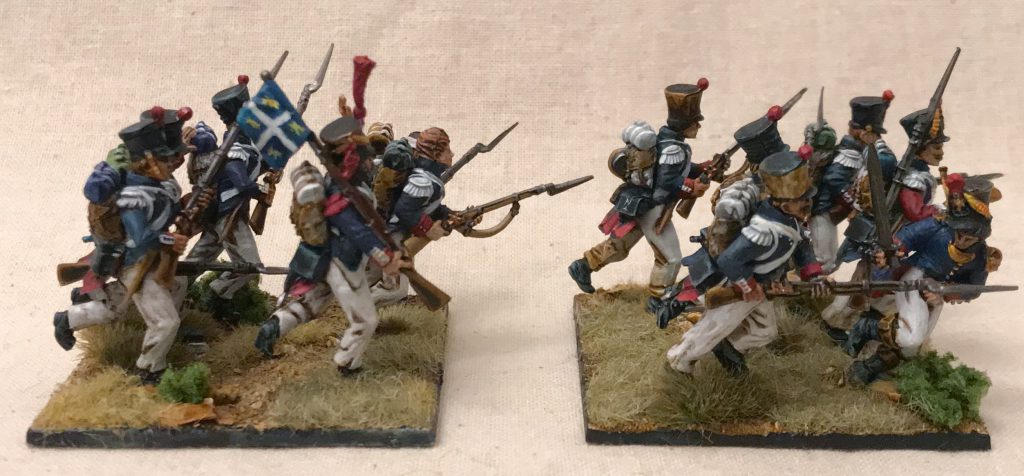
If I was being a bit stricter, I’d have these as the Velites of Florence so they would be in the same division of the Guard as the Chasseurs, but then I spent ages painting a tiny Turin fanion, so sod it. The models are a free and easy mix of all three Perry French plastic sets – Elite, Infantry and Batallion. To give me more epaulette-equipped arms (most Imperial Guard wore Epaulettes), spares from the Victrix Guard are in there too. The casualty figures are from Perry.
The stupid speak of the past, the fools of the future
With one battalion of Old and Middle Guard now fully finished, at the time of writing I’ve started to finish up the 2nd regiment of Chasseurs and made a start on another Middle and my first Young Guard battalion. Next time I’ll have a look at more modelling and basing choices as I try to leverage static poses into interesting visuals. In the meantime, and to start a new tradition for these articles, I’m going to present Napoleonic badass of the week.
Angelique Duchemin, the Widow Brulon
Angelique (born 1772) followed her Soldier husband into the 42nd line in Corsica, fought hard and was promoted up through the NCO ranks to Sergeant Major. She was involved in some vicious hand to hand against the perfidious British when in command of the Gesco Fort, fighting with knives in close quarters and was heavily wounded. She later fought at Calvi, where stiff resistance held the citadel long enough to cost Nelson his eye several days later. Her soldiers wrote in her defence and explanation – openly referring to her as “the Widow Brulon” attesting to her leadership and bravery. She was sent to the Invalides after a dedicated campaign to allow her into the great military hospital and retirement home in Paris, where she lived until her death in 1859. She received the Legion of Honour for her service and general badass-ness in 1851, having lived as a retired soldier and worn uniform consistently.
Have any questions or feedback? Drop us a note in the comments below or email us at contact@goonhammer.com.

